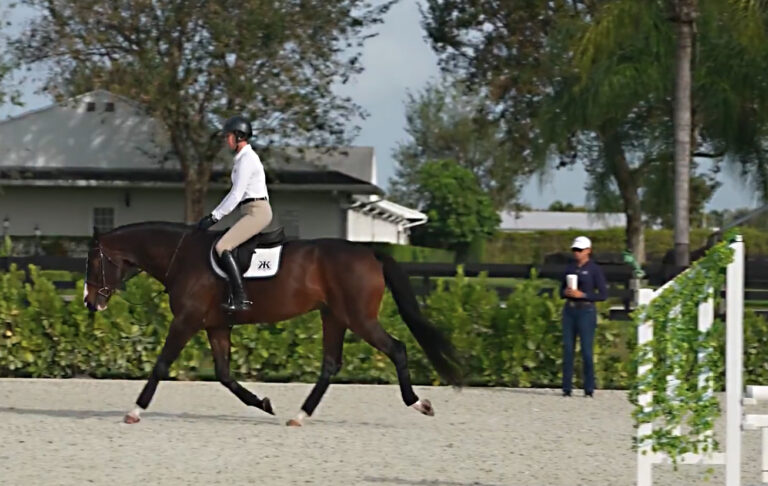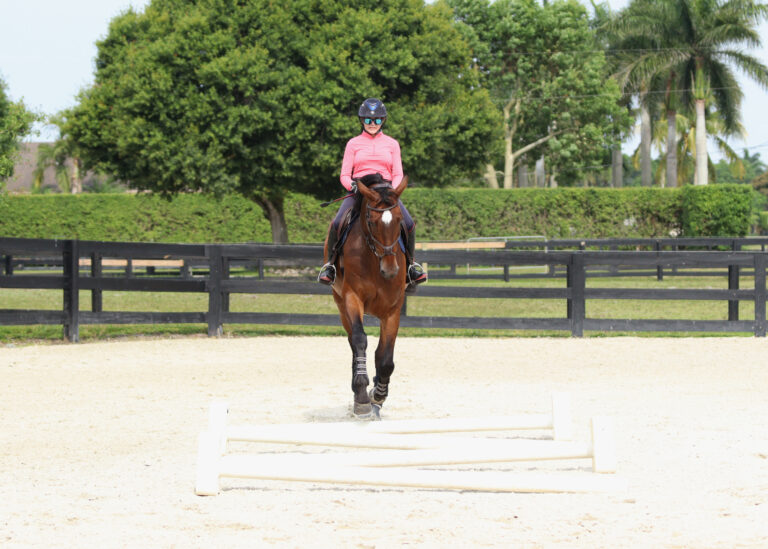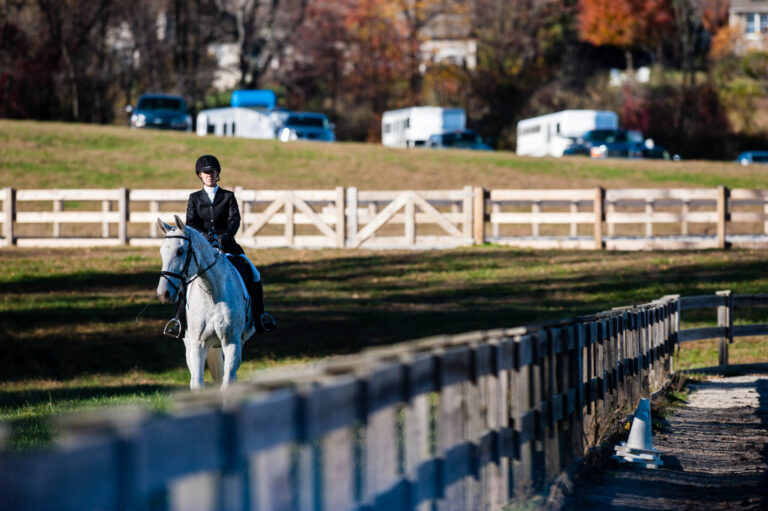My father, a building contractor, was involved in breeding and developing young horses on the family’s 28-acre farm in Omagh, County Tyrone, Northern Ireland, as a side business, so I started riding early, at age 6, with my brothers. When I was 13, a pony reared up on the road and fell on me and I broke my femur, which landed me in traction in the hospital for six months. During this time, I started reading books, and from them I learned about gymnastic exercises. I still read those books, including Training Showjumpers by Anthony Paalman and, more recently, 101 Jumping Exercises for Horse & Rider by Linda Allen, and use them as a base, combined with my own ideas, for refining the gymnastics I set up twice a week at Hermitage Farm in Bedminster, New Jersey, where I now train.
Gymnastic jumping—systematic exercises utilizing two or more obstacles placed in a row one to five strides apart—is such a mainstay in my program because it develops confidence in horses and teaches them to jump better. Jumping the same distances repeatedly helps a horse’s balance as he gets used to jumping in a consistent rhythm. And by changing a gymnastic slightly, you also can help solve training challenges such as drifting, lengthening a short stride or squaring up uneven legs.
In this article, I’ll show you how to ride a useful gymnastic—a vertical–vertical–oxer line—that will teach your horse to be careful and scopey. I’ll start by explaining how I introduce horses to gymnastic jumping and gradually progress to this three-jump line. For more advanced horses, I’ll add a bending line at the end of the basic gymnastic to counter a horse’s tendency to play when he thinks he’s finished and help maintain his focus after completing the jumps on a straight line. I’ll also tell you how to use gymnastics to resolve common training issues.
Before describing my gymnastic-jumping program, I want to remind you to always have a helper. I have someone in the ring when I jump to adjust the fences and be my eyes on the ground, but even more important, for safety reasons. I don’t believe in jumping when I’m alone, and that’s a rule everyone in our barn follows. Anything can happen—a horse can trip or spook—so make sure you have someone there with you.
Start Simple, Then Build
In the vertical–vertical–oxer gymnastic line I mentioned, you eventually will be jumping a vertical to vertical with 33–36 feet between the jumps, which is two strides when you take into account the landing and takeoff strides. That will encourage your horse to get off his forehand and push from his hocks. Then there are 45–48 feet (three strides) to the final oxer, which will make your horse stretch. While the goal is to work with distances so that one horse stride is 12 feet, which is what most course designers utilize, you want to vary the distance you use in a gymnastic to make your horse comfortable depending on the length of his stride.

You can ride this exercise going in both directions to develop different skills. Starting with the verticals first, the three strides to the oxer can be a little long because your horse will need to be careful over the verticals, landing a little close to the second one. When you begin with the square oxer, the three strides will ride a little shorter because your horse will jump in with scope, landing a little farther into the line, and then have to be careful for the verticals. This replicates what course builders do, requiring you to go forward over one jump, then having you shorten your horse’s stride for the next one.
But as I’ve indicated, the biggest factor to keep in mind when doing any gymnastic work is to start small and easy for your horse and progress gradually. Lay out poles on the ground in the same pattern you will use for crossrails to rehearse what you’re going to do with the actual jumps in the gymnastic. Don’t move on to a more challenging setup until your horse is relaxed riding through the current exercise and has fixed problems you are trying to address. You’re not trying to “catch him” doing something wrong. If he knocks down the jump every time, he isn’t learning anything and you’re going to panic him. He’ll end up not enjoying the work, which has to be a little fun for him to get the maximum benefits.
So with young horses, I begin this gymnastic exercise by trotting over a single pole on the ground. I focus on keeping a steady rhythm, maintaining straightness and going over the center of the pole. I pick a target at the end of the arena, a tree or a fence, and lock my eyes onto it all the way through the distance. That keeps my balance through the line. Without a target, a rider could veer left or right. After trotting over the pole, I reverse and go over the pole in the opposite direction.

A young horse might weave left or right coming down to the pole, so I may need to repeat the exercise several times, focusing on keeping him straight. Once he is relaxed and straight over the single pole, I canter it out of a steady pace, looking at my focal point. When my horse is relaxed and cantering over the single pole smoothly, I add a second pole 33–36 feet away on a straight line and trot back and forth over both of them. When I begin with inexperienced horses, the gymnastics always are set on straight lines because that teaches them to go straight. If you’re riding in an indoor arena, you can move the fences in by about a foot because horses don’t take as big a stride indoors.
Again, once my horse is relaxed at the trot, I canter both ground poles in a straight line in three strides. If all of that is going well, I add a third pole on the ground 45–48 feet from the second pole. Again, I trot over all three in both directions and then canter the line in three strides to four strides and reverse and ride it in four strides to three strides.
When my horse seems relaxed and is straight cantering all three ground poles, I make the second pole a crossrail and then canter the exercise in both directions. I canter over the first pole, allow my horse to take three strides, jump the crossrail and then take three or four strides to the final pole. While I’m looking for a distance to the first element, it’s not a big deal if I don’t see one. No matter what distance I get, once my horse goes over the first element, he’s set up for the correct distance to the next one.
The construction of a crossrail helps to keep a horse in the center of the jump and stops him from drifting left or right. To ride it correctly, you have to have him centered on the jump and you also have to be centered on him.
At this point in the exercise, I set a pole or a little jump, perhaps 6 inches high, off a turn at the end of the gymnastic. This gives me an opportunity to end the exercise neatly and keeps my horse thinking about what he’s doing, as opposed to playing, bucking or leaning on the bit when he has landed after the gymnastic.
Once my horse is jumping the gymnastic with the middle element a crossrail, I make the last pole a crossrail and canter over the exercise on both the right and left leads, so I’m riding over the ground pole and then the two crossrails. When I reverse the exercise, I canter the two crossrails and then the ground pole. Finally, I make the first ground pole a crossrail so that all three of the ground poles are crossrails, and I canter the crossrail line in the direction that enables me to ride the first crossrail in two strides to the middle crossrail and finally three strides to the last crossrail. Then I reverse and jump the line back in three strides to two strides.

As I canter through the crossrails, I focus on maintaining my position and letting my horse work out how to ride the exercise. If I jump in and think I’m going to get a little deep, I don’t fix it by putting on more leg. I let my horse figure out the striding and takeoff spot for himself. The fences aren’t big enough to scare him. I pick a spot at the end of the ring to focus on and think about my balance and staying with my horse’s motion. I let him focus on the fences.
Once my horse is confident over the crossrails, I follow a similar gradual progression to build the crossrails into verticals. I start by making the middle crossrail a small vertical, no more than 2 feet or 2-foot-6. (Once I build verticals, I keep all the fences the same height.)
At this point, I put a ground line on either side of the vertical about a foot from the base of the fence. This will help my horse measure his distance to the fence. Again, I canter back and forth over the exercise. Then I make the last crossrail a vertical with ground lines and jump back and forth over it until he’s comfortable. Next I make the first crossrail a vertical and canter back and forth over it. Once he’s confident over the line of verticals, I convert the final vertical to an oxer.
How quickly I progress from the poles to the final gymnastic all depends on the horse and how he’s handling the work. If I’m riding a 4-year-old, getting to the point where we are jumping this final gymnastic could take a couple of weeks, while a 5-year-old could be jumping through the whole gymnastic in two weeks.




Add a Bending Line
Once your horse is jumping the straight-line, three-element gymnastic exercise confidently, you can add a bending line after it to keep his attention.
If you consider the end of the three-element gymnastic as being at 12 o’clock on the face of a clock, set verticals at about 60 feet from the center of the oxer to the left and right of the gymnastic, one at 10 o’clock and one at 2 o’clock, both at a 30-degree angle. Having a jump on either side of the gymnastic gives a rider the option of going left or right.
Don’t worry about being exact when measuring the bend because not everything’s perfect when you get to the show ring. If the distance is a little long in four strides or short in five, your horse will be able to figure it out. Also, you can add or leave out a stride by staying to the outside or inside of the bending line.
To ride the gymnastic in the opposite direction starting with the oxer, place two more verticals 60 feet from the first vertical in the gymnastic line to the left and right at 4 o’clock and 8 o’clock at the 30-degree angle so you can do the same exercise when you finish the gymnastic going the other way too.
When teaching students, I wait until they are on the approach to the first element of the gymnastic before telling them what direction to go after they finish the straight gymnastic and the number of strides I want them to put in on the bending line. That way, they have to think a little faster. And if the horse isn’t listening to them, they won’t get the result I want.
Addressing Problems
You can target a horse’s weaknesses through the type of gymnastics you build.
Problem 1: If my horse isn’t jumping the verticals well, I move the ground poles out so they are about 18 inches from the fence, which gives him a little more room for taking off.
Problem 2: If I’m riding a horse with a bit of a short stride, I shorten the distances between the poles and then the jumps so he can go through them comfortably. Eventually, I’ll lengthen the distances, hoping to extend his stride so that each one covers 12 feet because most of the courses that we jump are measured for horses with a 12-foot stride.
On a hot horse who wants to go through a gymnastic a little fast, I lengthen the distance by half a foot per stride, so the 36-foot distance would increase to
37 ½ feet to stop him from getting anxious. But once he gets used to doing it, the goal is to shorten it up.
Problem 3: If my helper tells me my horse’s legs aren’t even over a fence—for instance, his right leg is hanging a little—I raise the right side of the fence by about two holes to correct it. Most horses prefer to jump the lowest part of the fence.
Problem 4: I do the same thing if my horse is drifting. If he wants to go to the right all the time, I build the right-hand side higher to encourage him to jump in the center of the fence. He has to work harder to jump higher, so he should move back to the lower, center part of the fence.
Straightness is so important because when a course designer wheels his track, he goes in a straight line. If you have a horse who shifts to the left or right as he jumps this gymnastic, instead of the three-stride line from the middle vertical to the oxer being 48 feet, the horse has made it 50 or 52 feet because of his drift, so he’s not at the perfect takeoff point. He’s actually 2 or more feet farther away. That means the arc of the jump is going to be wider and flatter for you, and there is more of a chance he will knock down a rail.
Problem 5: If I want to improve my horse’s bascule, I ramp the oxer so the back rail is 6 inches higher than the front rail. Just be sure not to ride the exercise in the reverse direction until you switch the position of the rails.
Gymnastics are useful in improving the confidence of your horse and teaching him to jump better. Follow a gradual progression from poles to crossrails to bigger fences to keep it fun for your horse—so you both can reap all of the benefits.
This article originally appeared in the July 2014 issue of Practical Horseman.











